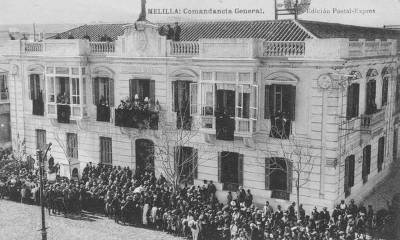MENÚ UNIDAD
ARMY UNITS
- Araba Álava |
- Albacete |
- Alicante |
- Almería |
- Asturias |
- Ávila |
- Badajoz |
- Barcelona |
- Burgos |
- Cáceres |
- Cádiz |
- Cantabria |
- Castellón |
- Ceuta |
- Ciudad Real |
- Córdoba |
- A Coruña |
- Cuenca |
- Girona |
- Granada |
- Guadalajara |
- Gipuzkoa |
- Huelva |
- Huesca |
- Islas Baleares |
- Jaén |
- León |
- Lleida |
- Lugo |
- Madrid |
- Málaga |
- Melilla |
- Murcia |
- Navarra |
- Ourense |
- Palencia |
- Las Palmas |
- Pontevedra |
- La Rioja |
- Salamanca |
- Segovia |
- Sevilla |
- Soria |
- Tarragona |
- Santa Cruz de Tenerife |
- Teruel |
- Toledo |
- Valencia |
- Valladolid |
- Bizkaia |
- Zamora |
- Zaragoza

Background

Since its inception, the Commandancy-General of Melilla, as well as its twin sister in Ceuta, is one of the Spanish military units with the longest historical tradition and it includes, amongst others, the most ancient unit of the Army, the so-called Compañía de Mar de Melilla (Company of the Sea from Melilla)—currently reporting to the 24th Logistics Unit (ULOG)—which, with its “forty men of the sea” arrived in Melilla under the command of Don Pedro de Estopiñán in 1497.
Established as a commanding body able to assume either the garrison troops stationed in the town or the expeditionary troops sent from the Peninsula on the occasion of the campaign that started in October 1893, the personnel in the Commandancy-General varied according to the political-military situation of each moment, and has always been involved in the historic events that befell in its area of responsibility or in its vicinity during the nearly fifty years that the Spanish Protectorate in Morocco spanned.
After the brief campaign of 1893, it was in 1909 when it fully engaged, under the command of General Marina, in re-establishing the war situation caused by the Kabyles in the vicinity and imposing the authority of the Sultan of Morocco by virtue of the agreements signed at the Algeciras Conference in 1906. In 1911, a third campaign lasting one year caused that the area of influence of the Commandancy-General expanded over the west zone of the Gurugú massif, and by means of a wise political leadership reached the left bank of Muluya river after finishing the military operations. This river was in fact the eastern border of the Spanish Protectorate with the French one.
The military operations of advance towards the west were resumed after the First World War, in 1920, deploying troops up to the area of Annual, at the beginning of 1921. After the events known as the "Annual Campaign", in mid-July of that year, a quick response that same October led to conquer the lost territories and restore the situation. This allowed in 1925 the great military operation known as the "Landing of Al Hoceima", the beginning of the end of a war that ended in the summer of 1927 and allowed the creation of today's Morocco.
The Spanish military history has a very special bond with the city of Melilla since its incorporation to the Crown of Castile on September 17, 1497. An important part of this history has been written by its heroes; that is why in the Cemetery of the Immaculate Conception of Melilla there are countless military protagonists of stories, stories of deeds of arms, decorated soldiers, etc., which enhance the historical heritage of our Armed Forces. This makes of the Cemetery a true Pantheon of Heroes of Spain. At present, there are approximately 12,000 military personnel of all corps and ranks in this Cemetery.



